Archives - Page 2
-
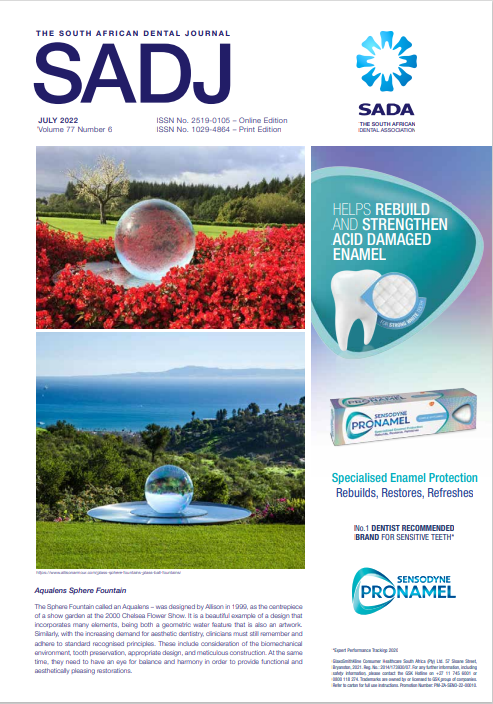
The South African Dental Journal
Vol. 77 No. 06 (2022)The Sphere Fountain called an Aqualens – was designed by Allison in 1999, as the centrepiece
of a show garden at the 2000 Chelsea Flower Show. It is a beautiful example of a design that
incorporates many elements, being both a geometric water feature that is also an artwork.
Similarly, with the increasing demand for aesthetic dentistry, clinicians must still remember and
adhere to standard recognised principles. These include consideration of the biomechanical
environment, tooth preservation, appropriate design, and meticulous construction. At the same
time, they need to have an eye for balance and harmony in order to provide functional and
aesthetically pleasing restorations. -
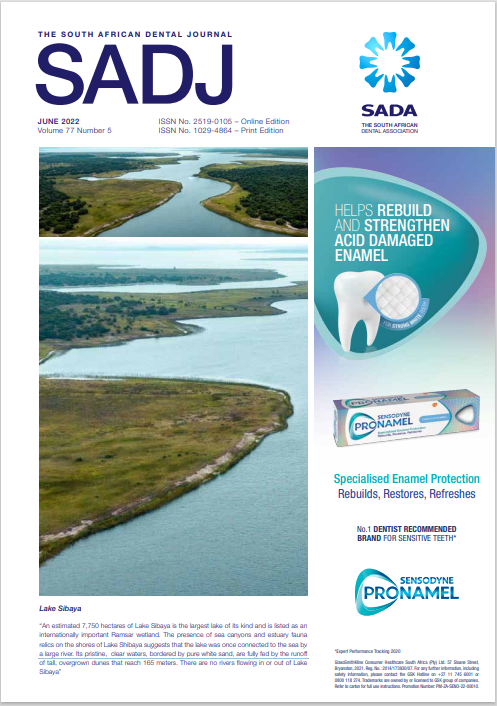
The South African Dental Journal
Vol. 77 No. 05 (2022)Lake Sibaya
“An estimated 7,750 hectares of Lake Sibaya is the largest lake of its kind and is listed as an internationally important Ramsar wetland. The presence of sea canyons and estuary fauna relics on the shores of Lake Shibaya suggests that the lake was once connected to the sea by a large river. Its pristine, clear waters, bordered by pure white sand, are fully fed by the runoff of tall, overgrown dunes that reach 165 meters. There are no rivers flowing in or out of Lake Sibaya” -

The South African Dental Journal
Vol. 77 No. 04 (2022)Waterfall Boven
Waterval Boven, whose Dutch name means “above the waterfall” is built above the Elands River Falls on the historic Pretoria to Maputo railway line. The sister town Waterval Onder is at the base of the escarpment. -
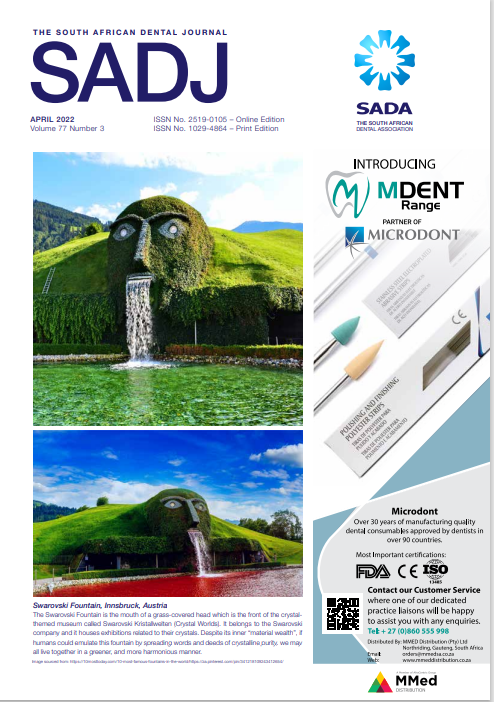
The South African Dental Journal
Vol. 77 No. 03 (2022)Swarovski Fountain, Innsbruck, Austria
The Swarovski Fountain is the mouth of a grass-covered head which is the front of the crystal themed museum called Swarovski Kristallwelten (Crystal Worlds). It belongs to the Swarovski company and it houses exhibitions related to their crystals. Despite its inner “material wealth”, if humans could emulate this fountain by spreading words and deeds of crystalline purity, we may all live together in a greener, and more harmonious manner. -
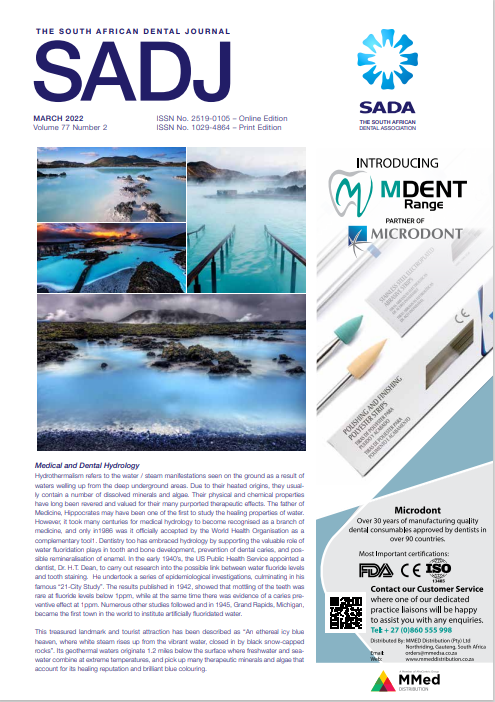
The South African Dental Journal
Vol. 77 No. 02 (2022)Medical and Dental Hydrology
Hydrothermalism refers to the water / steam manifestations seen on the ground as a result of
waters welling up from the deep underground areas. Due to their heated origins, they usually contain a number of dissolved minerals and algae. Their physical and chemical properties have long been revered and valued for their many purported therapeutic effects. The father of Medicine, Hippocrates may have been one of the first to study the healing properties of water. However, it took many centuries for medical hydrology to become recognised as a branch of medicine, and only in1986 was it officially accepted by the World Health Organisation as a complementary tool1. Dentistry too has embraced hydrology by supporting the valuable role of water fluoridation plays in tooth and bone development, prevention of dental caries, and possible remineralisation of enamel. In the early 1940’s, the US Public Health Service appointed a dentist, Dr. H.T. Dean, to carry out research into the possible link between water fluoride levels and tooth staining. He undertook a series of epidemiological investigations, culminating in his famous “21-City Study”. The results published in 1942, showed that mottling of the teeth was rare at fluoride levels below 1ppm, while at the same time there was evidence of a caries preventive effect at 1ppm. Numerous other studies followed and in 1945, Grand Rapids, Michigan,
became the first town in the world to institute artificially fluoridated water. This treasured landmark and tourist attraction has been described as “An ethereal icy blue heaven, where white steam rises up from the vibrant water, closed in by black snow-capped rocks”. Its geothermal waters originate 1.2 miles below the surface where freshwater and seawater combine at extreme temperatures, and pick up many therapeutic minerals and algae that account for its healing reputation and brilliant blue colouring. -
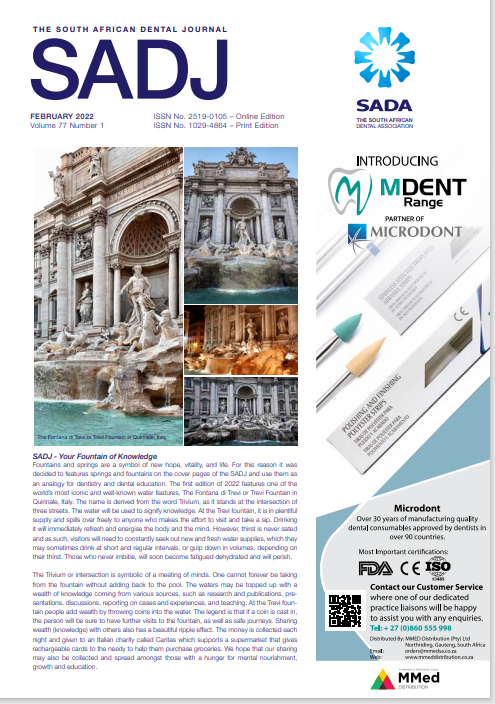
The South African Dental Journal
Vol. 77 No. 01 (2022)SADJ - Your Fountain of Knowledge
Fountains and springs are a symbol of new hope, vitality, and life. For this reason it was decided to features springs and fountains on the cover pages of the SADJ and use them as an analogy for dentistry and dental education. The first edition of 2022 features one of the world’s most iconic and well-known water features, The Fontana di Trevi or Trevi Fountain in Quirinale, Italy. The name is derived from the word Trivium, as it stands at the intersection of three streets. The water will be used to signify knowledge. At the Trevi fountain, it is in plentiful supply and spills over freely to anyone who makes the effort to visit and take a sip. Drinking it will immediately refresh and energise the body and the mind. However, thirst is never sated and as such, visitors will need to constantly seek out new and fresh water supplies, which they may sometimes drink at short and regular intervals, or gulp down in volumes, depending on their thirst. Those who never imbibe, will soon become fatigued dehydrated and will perish. The Trivium or intersection is symbolic of a meeting of minds. One cannot forever be taking from the fountain without adding back to the pool. The waters may be topped up with a wealth of knowledge coming from various sources, such as research and publications, presentations, discussions, reporting on cases and experiences, and teaching. At the Trevi fountain people add wealth by throwing coins into the water. The legend is that if a coin is cast in, the person will be sure to have further visits to the fountain, as well as safe journeys. Sharing wealth (knowledge) with others also has a beautiful ripple effect. The money is collected each night and given to an Italian charity called Caritas which supports a supermarket that gives
rechargeable cards to the needy to help them purchase groceries. We hope that our sharing may also be collected and spread amongst those with a hunger for mental nourishment, growth and education -
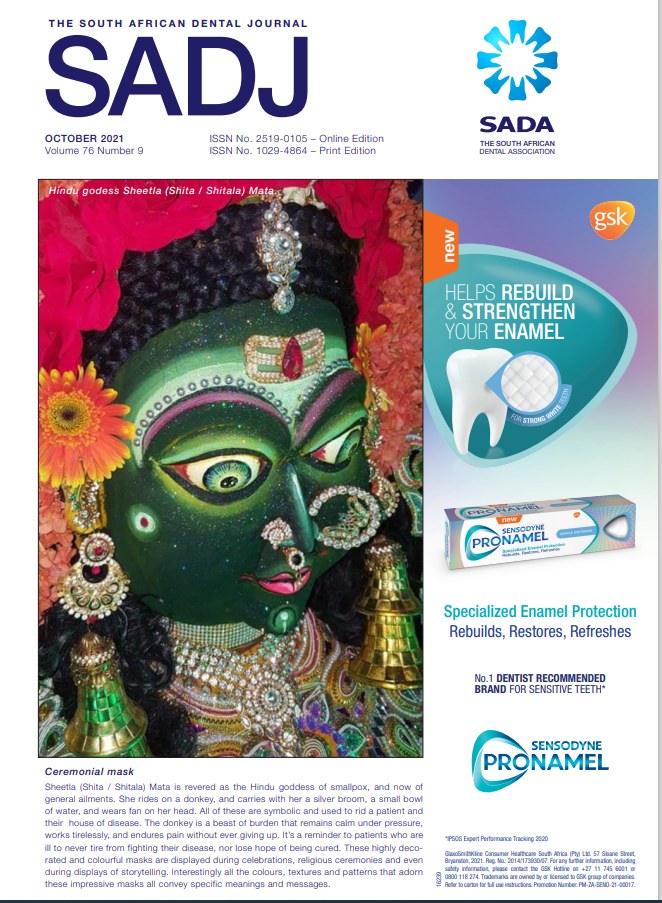
The South African Dental Journal
Vol. 76 No. 09 (2021)Ceremonial mask
Sheetla (Shita / Shitala) Mata is revered as the Hindu goddess of smallpox, and now of general ailments. She rides on a donkey, and carries with her a silver broom, a small bowl of water, and wears fan on her head. All of these are symbolic and used to rid a patient and their house of disease. The donkey is a beast of burden that remains calm under pressure, works tirelessly, and endures pain without ever giving up. It’s a reminder to patients who are ill to never tire from fighting their disease, nor lose hope of being cured. These highly decorated and colourful masks are displayed during celebrations, religious ceremonies and even during displays of storytelling. Interestingly all the colours, textures and patterns that adorn these impressive masks all convey specific meanings and messages. -
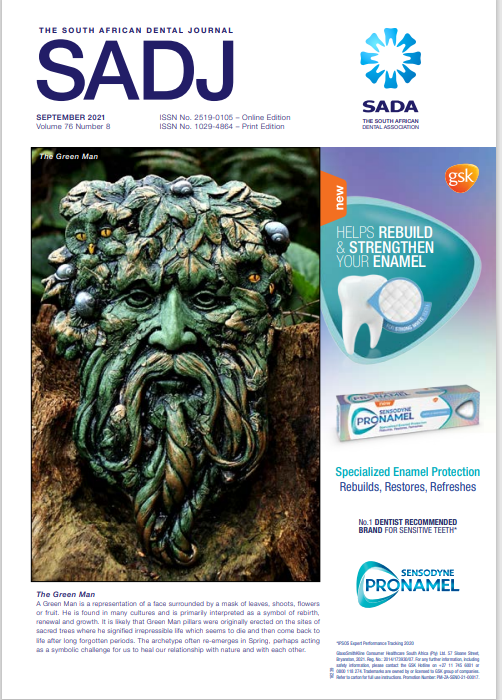
The South African Dental Journal
Vol. 76 No. 08 (2021)The Green Man
A Green Man is a representation of a face surrounded by a mask of leaves, shoots, flowers or fruit. He is found in many cultures and is primarily interpreted as a symbol of rebirth, renewal and growth. It is likely that Green Man pillars were originally erected on the sites of sacred trees where he signified irrepressible life which seems to die and then come back to life after long forgotten periods. The archetype often re-emerges in Spring, perhaps acting as a symbolic challenge for us to heal our relationship with nature and with each other. -

South African Dental Journal
Vol. 76 No. 07 (2021)Venetian masks are a centuries-old tradition of Venice, Italy. They were used to hide the wearer’s identity and social status allowing the person to “be who they wanted to be, and do what they wanted to do” for that day. A poor man could be a nobleman, a woman could act like a man, or vice versa. Traditionally people were allowed to wear them during the Carnival of Venice, from the start of the carnival season (The festival of Santo Stefano, December 26) and throughout the festivities. They were also worn at midnight on Shrove Tuesday, during Ascension and from October 5 to Christmas, thus people could spend a large proportion of the year in disguise. Mask makers (mascareri) enjoyed a special position in society, with their own laws and their own guild. Perhaps we could wear similar masks during women’s
month of August allowing people of all sexes, race and age groups to enjoy equal rights, and privileges, but then maintain the momentum throughout the rest of the year! -
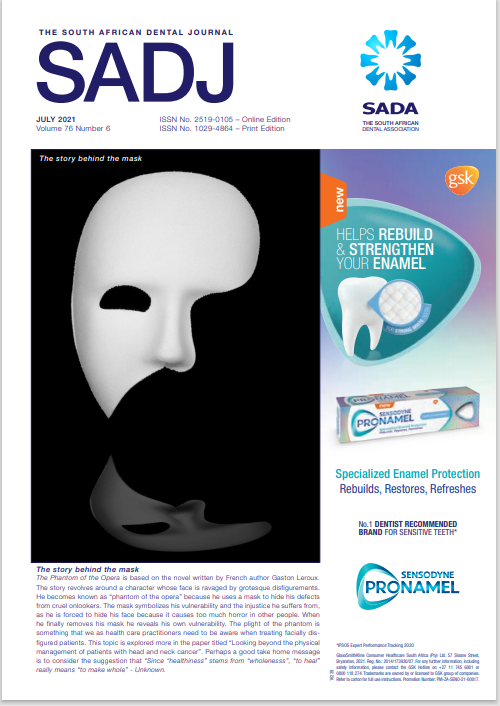
South African Dental Journal
Vol. 76 No. 06 (2021)The story behind the mask
The Phantom of the Opera is based on the novel written by French author Gaston Leroux. The story revolves around a character whose face is ravaged by grotesque disfigurements. He becomes known as “phantom of the opera” because he uses a mask to hide his defects from cruel onlookers. The mask symbolizes his vulnerability and the injustice he suffers from, as he is forced to hide his face because it causes too much horror in other people. When he finally removes his mask he reveals his own vulnerability. The plight of the phantom is something that we as health care practitioners need to be aware when treating facially disfigured patients. This topic is explored more in the paper titled “Looking beyond the physical management of patients with head and neck cancer”. Perhaps a good take home message is to consider the suggestion that “Since “healthiness” stems from “wholenesss”, “to heal”
really means “to make whole” - Unknown. -
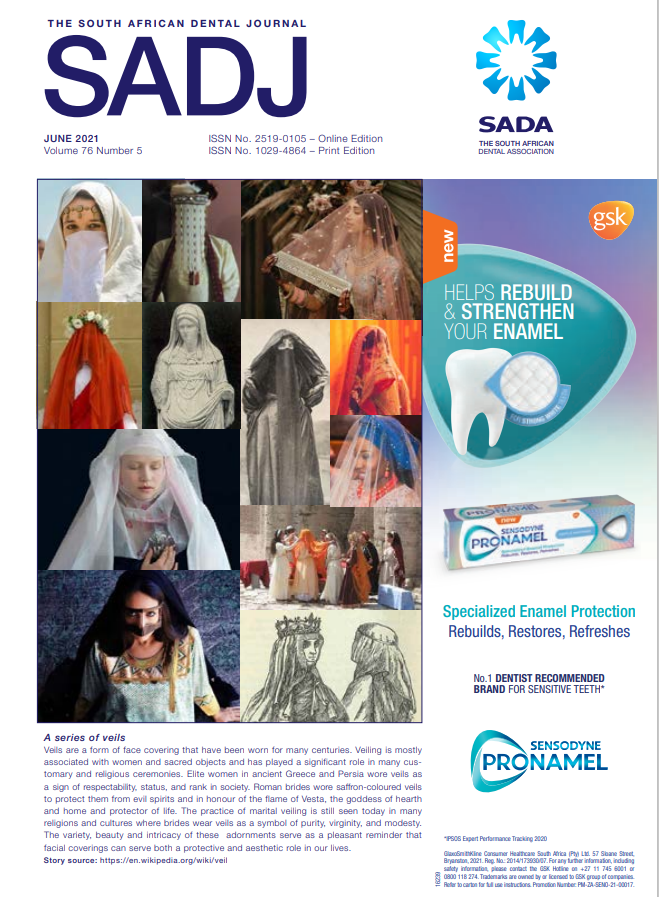
South African Dental Journal
Vol. 76 No. 5 (2021)Veils are a form of face covering that have been worn for many centuries. Veiling is mostly associated with women and sacred objects and has played a significant role in many customary and religious ceremonies. Elite women in ancient Greece and Persia wore veils as a sign of respectability, status, and rank in society. Roman brides wore saffron-coloured veils to protect them from evil spirits and in honour of the flame of Vesta, the goddess of hearth and home and protector of life. The practice of marital veiling is still seen today in many religions and cultures where brides wear veils as a symbol of purity, virginity, and modesty. The variety, beauty and intricacy of these adornments serve as a pleasant reminder that facial coverings can serve both a protective and aesthetic role in our lives.
-
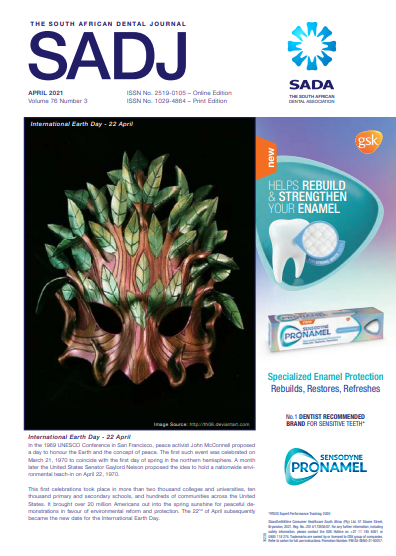
South African Dental Journal
Vol. 76 No. 3 (2021)About the Cover Page - International Earth Day - 22 April
In the 1969 UNESCO Conference in San Francisco, peace activist John McConnell proposed a day to honour the Earth and the concept of peace. The first such event was celebrated on March 21, 1970 to coincide with the first day of spring in the northern hemisphere. A month later the United States Senator Gaylord Nelson proposed the idea to hold a nationwide environmental teach-in on April 22, 1970. This first celebrations took place in more than two thousand colleges and universities, ten thousand primary and secondary schools, and hundreds of communities across the United States. It brought over 20 million Americans out into the spring sunshine for peaceful demonstrations in favour of environmental reform and protection. The 22nd of April subsequently became the new date for the International Earth Day.
-

South African Dental Journal
Vol. 76 No. 2 (2021)About the Cover Page - Beaked Plague Doctor Mask
Paul Fürst, engraving, c. 1721, of a plague doctor of Marseilles (introduced as ‘Dr Beaky of Rome’). His nose-case is filled with herbal material to keep off the plague. Medical mask-wearing has a long history dating back to the popular beaded masks worn by doctors in the 17th century during the plague epidemic. They believed that the disease spread through miasmas - bad smells that wafted through the air. Their clothing was thus intended to protect them from these airborne diseases. The original “beak doctor” costume was believed to
have been invented by the French doctor Charles de Lorme in 1619 who advocated doctors and surgeons wear a full head-to-toe protective garment. It consisted of an ankle-length overcoat, boots, a wide rimmed hat (that indicated their profession), and a bird-like beak mask. The mask had glass openings for the eyes and a curved beak shaped like a bird’s beak with straps that held it in front of the doctor’s nose. -
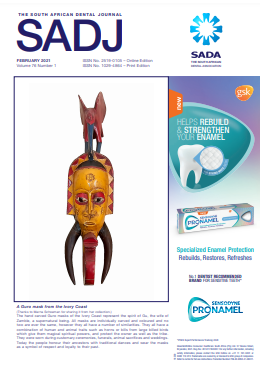
South African Dental Journal
Vol. 76 No. 1 (2021)About the Cover Page - A Guro mask from the Ivory Coast
(Thanks to Marna Schoeman for sharing it from her collection.)The hand carved Guro masks of the Ivory Coast represent the spirit of Gu, the wife of Zamble, a supernatural being. All masks are individually carved and coloured and no two are ever the same, however they all have a number of similarities. They all have a combination of human and animal traits such as horns or bills from large billed birds which give them magical spiritual powers, and protect the owner as well as the tribe. They were worn during customary ceremonies, funerals, animal sacrifices and weddings. Today the people honour their ancestors with traditional dances and wear the masks as a symbol of respect and loyalty to their past.
-
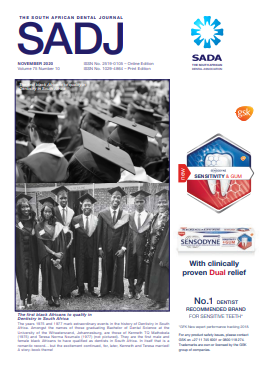
South African Dental Journal
Vol. 75 No. 10 (2020)About the Cover Page
The theme for the Front Cover of the South African Dental Journal this year provides for some historical figures, some characters illuminating dental history and some important achievements in South African Dental history. The cover for November looks back to the first black Africans to qualify in Dentistry in South Africa.
The years 1975 and 1977 mark extraordinary events in the history of Dentistry in South Africa. Amongst the names of those graduating Bachelor of Dental Science at the University of the Witwatersrand, Johannesburg, are those of Kenneth TQ Mathobela (1975) and Teresa Norma Nxumalo (1977) (not pictured). They are the first male and female black Africans to have qualified as dentists in South Africa. In itself that is a romantic record ... but the excitement continued, for, later, Kenneth and Teresa married! A storybook theme!
-
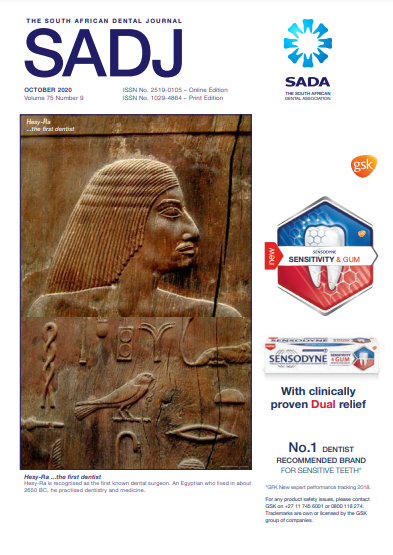
South African Dental Journal
Vol. 75 No. 9 (2020)About the Cover Page
The theme for the Front Cover of the South African Dental Journal this year provides for some historical figures, some characters illuminating dental history and some important achievements in South African Dental history. The cover for October looks at an Egyptian recognised as the first dentist. Hesy-Ra is recognised as the first known dental surgeon. An Egyptian who lived in about 2650 BC, he practised dentistry and medicine.
-
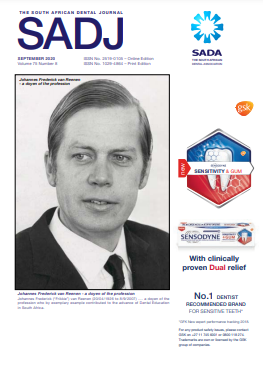
South African Dental Journal
Vol. 75 No. 8 (2020)About the Cover Page
Johannes Frederick (“Frikkie”) van Reenen (20/04/1926 to 8/9/2007) …. a doyen of the profession who by exemplary example contributed to the advance of Dental Education in South Africa.
-
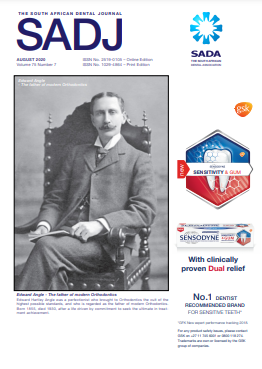
South African Dental Journal
Vol. 75 No. 7 (2020)About the Cover Page
Edward Angle - The father of modern Orthodontics - was a perfectionist who brought to Orthodontics the cult of the highest possible standards, and who is regarded as the father of modern Orthodontics. Born 1855, died 1930, after a life driven by commitment to seek the ultimate in treatment achievement.
-
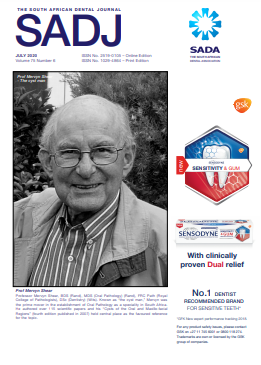
South African Dental Journal
Vol. 75 No. 6 (2020)About the Cover Page
Professor Mervyn Shear, BDS (Rand), MDS (Oral Pathology) (Rand), FRC Path (Royal College of Pathologists), DSc (Dentistry) (Wits). Known as “the cyst man,” Mervyn was the prime mover in the establishment of Oral Pathology as a speciality in South Africa. He authored over 115 scientific papers and his “Cysts of the Oral and Maxillo-facial Regions” (fourth edition published in 2007) held central place as the favoured reference for the topic.
-
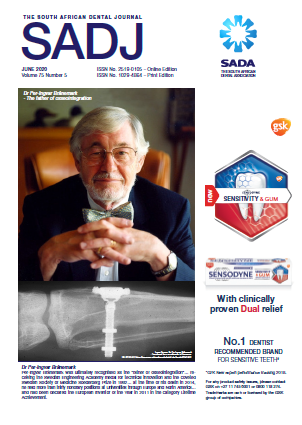
South African Dental Journal
Vol. 75 No. 5 (2020)About the Cover Page
Dr Per-Ingvar Brånemark was ultimately recognised as the “father of osseointegration”. He received the Swedish Engineering Academy medal for technical innovation and the coveted Swedish Society of Medicine Soederberg Prize in 1992. At the time of his death in 2014, he held more than thirty honorary positions at Universities through Europe and North America and had been declared the European Inventor of the Year in 2011 in the category Lifetime Achievement.
-
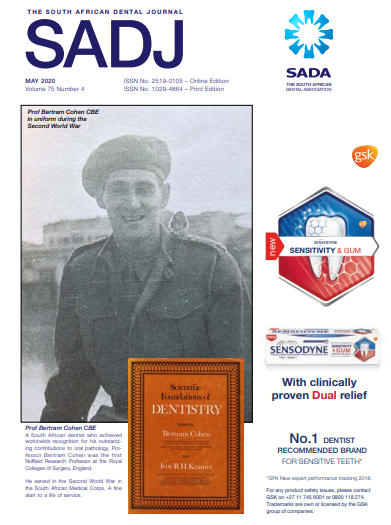
South African Dental Journal
Vol. 75 No. 4 (2020)About the Cover Page
Prof Bertram Cohen CBE, a South African dentist who achieved worldwide recognition for his outstanding contributions to oral pathology. Prof Bertram Cohen was the first Nuffield Research Professor at the Royal Colleges of Surgery, England. He served in the Second World War in the South African Medical Corps. A fine start to a life of service.

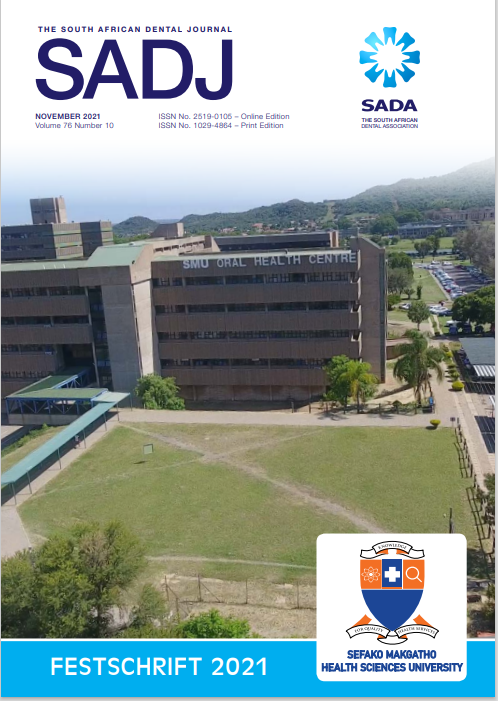
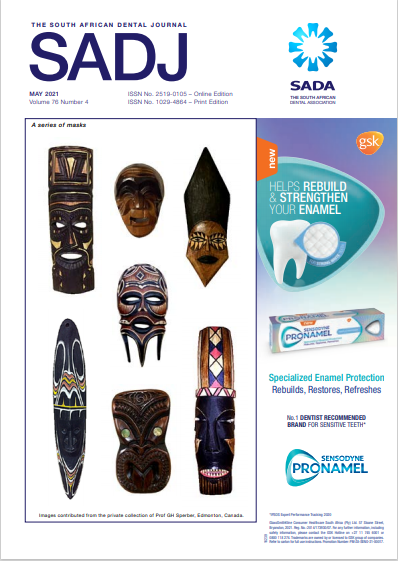



.png)